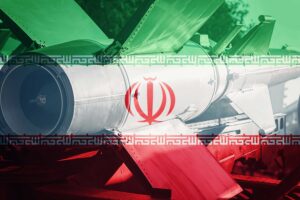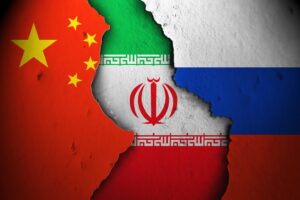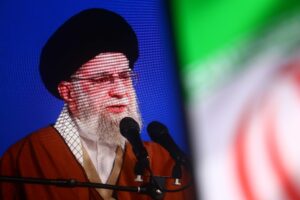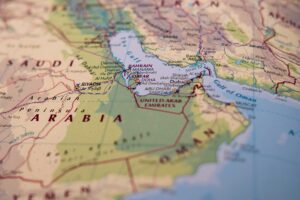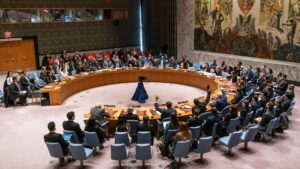In December 2020, several Arab media outlets reported that an unusual meeting between Syrian and Israeli officials was held at Russia’s Hmeimim Air Base on the Syrian coast. According to the reports, the delegations included the head of the Syrian National Security Bureau, Ali Mamlouk, and his special advisor for security and strategic affairs, Major General Bassam Hassan, while from Israel, both Lt. Gen. (ret.) Gadi Eisenkot, former chief of the general staff of the Israel Defense Forces (IDF), and former Israeli military intelligence official Ari Ben-Menashe attended.[i] This was presented as part of a Russian effort to promote a normalization agreement between Syria and Israel.
Although the meeting seems highly unlikely – and both sides have denied these reports – recent events in the Middle East, characterized by a diplomatic effort toward reconciliation and multilateralism, should be analyzed carefully.
Arab states, encouraged by Russia, are taking steps to end the decade-long isolation of Assad and restore Syria’s regional position.
Until recently, both Israel and Syria, each for its own reasons, were perceived as a pariah by most Arab countries. There were two significant political developments that led to a gradual shift in image of both states in the region. First, the Abraham Accords, i.e., the normalization of relations between Israel, the United Arab Emirates (UAE), and Bahrain that were signed in September 2020, followed by declarations of peace by Morocco and Sudan. These agreements transformed Israel from a taboo and an eternal enemy into a potential partner based on shared interests. Second is the recent regional willingness by several Arab states to engage with President Bashar al-Assad politically and economically. Those states, encouraged by Russia, are taking steps to end the decade-long isolation of Assad and restore Syria’s regional position.
The most dramatic move came from Jordan. In September 2021, Syria’s defense minister visited Jordan and met with Jordanian military officials,[ii] a meeting that resulted in the reopening of the Jordanian border with Syria for trade – part of Jordan’s attempt to revive its shattered economy. Moreover, a 10-year-old deal to transport Egyptian natural gas from Jordan via Syria to Lebanon, where an economic collapse has caused extensive blackouts, was also revived with tacit support from the Biden administration – exempting Jordan and other Arab countries from potential sanctions under the Caesar Act.[iii] A month later, Assad and King Abdullah II of Jordan spoke over the phone for the first time in ten years to discuss ties between the “brotherly countries.”[iv]
Warming of relations with Syria is not confined to Jordan but is part of a broader trend among a number of Arab states, including Egypt, Iraq, the UAE, and others. Egyptian foreign minister Sameh Shoukry announced that Cairo supported Arab normalization with Syria.[v] In October, Syria was invited to take part at the trade expo in Dubai, the first world’s fair in the Middle East. On the sidelines of the Expo, Syria and the UAE held talks to restore economic relations.[vi] A possible change in Riyadh’s attitude toward Syria is also evident. In May, Saudi Arabia dispatched its intelligence chief to Damascus for talks with his Syrian counterpart, and they reportedly discussed reopening embassies.[vii]
These two significant developments might affect the way Israel perceives Syria, and vice versa. An agreement with Israel might seem less unrealistic for Syria, given the region’s current political climate. From Israel’s perspective, the regional acceptance of Assad might encourage decision makers to take a similar path based on shared regional interests.
In return for Israel’s withdrawal from the Golan, Syria was to disengage from its alliance with Iran and Hezbollah, and sign a peace agreement with Israel.
Indeed, talks between Israel and Syria are not unprecedented. Since 1992 several Israeli prime ministers negotiated seriously with Hafez and Bashar al-Assad in an effort to resolve the Israeli-Syrian conflict; all used different versions of a formula that included a withdrawal from the Golan in return for a peace and security package. However, in the latest round, in 2010, when the Obama administration launched a mediation effort between Israel and Syria, it was predicated not on the familiar “land for peace” formula, rather on the notion of “land for strategic realignment.”[viii] In other words, in return for Israel’s withdrawal from the Golan, Syria was to disengage from its alliance with Iran and Hezbollah, and sign a peace agreement with Israel. This mediation was terminated by the outbreak of the Syrian rebellion.
Overlapping Interests?
As a Syrian and Arab regional interest as well as an Israeli one, the formula above appears primed for revival.
The Syrian president has two immediate objectives – he is interested in removing the sanctions in order to rehabilitate his ruined state and economy, and also aspires to resurrect his stature and gradually restore the sovereignty of the Syrian state.
Assad is grappling with an unprecedented economic crisis and lacks the ability to rebuild the destroyed country. Those who saved his government, Russia and Iran, cannot help with the vast budgets needed for economic reconstruction. In fact, the Syrian president has two immediate objectives – he is interested in removing the sanctions in order to rehabilitate his ruined state and economy, and also aspires to resurrect his stature and gradually restore the sovereignty of the Syrian state and its regional position. It is possible that under Russian encouragement, Assad is beginning to recognize that this time the solution may come from the Sunni-Gulf axis rather than from his “natural” ally, Iran.
This understanding puts him closer to the triangle of Israel, the United States, and Arab Sunni states that view Iran as a security threat and would like to see Iran, Hezbollah, and foreign militias pushed out of Syria. In other words, Israel’s upgraded relations with the Gulf states, fueled largely by the common rivalry with Iran, may in the long run also lead to cooperation in the Syrian arena.
For Israel, this seemingly presents as an opportunity to drive a wedge between Syria and Iran, within the framework of possible Arab recognition of Assad’s rule and economic aid to Syria in exchange for a reduced – if not eliminated – Iranian presence in Syria. Any settlement with Damascus would be contingent on the removal of Iran and its proxies from Syria. The Golan Heights will probably not be the first item on the agenda – Syria has more pressing issues in the current reality, and instead of resolving it, the parties would likely engage in endless rounds of negotiations, especially under the new Israeli Prime Minister who recently stated that: “Even in the situation – which could happen – in which the world changes direction regarding Syria, or regarding the [Bashar] Assad regime, this has no connection to the Golan Heights” and Israel’s sovereignty there.[ix]
From Russia’s perspective, apart from stabilizing Syria and securing its military and economic assets in the region, such a deal can certainly leverage its regional position by buying it an historic role in the Arab-Israeli peace process.
A potential agreement between Israel and Syria is often viewed as comprising two options. One is official bilateral negotiations that ultimately lead to a peace agreement or, on a smaller scale, to normalization.[x] A more modest possibility lies in the framework of a multilateral regional settlement in which Israel is not a formal party but agrees to accept the rules of the game, i.e., recognition of Assad and a commitment to refrain from any action that undermines him or Syrian sovereignty in exchange for Syria’s detachment from the axis and Iran’s ouster from its territory.[xi]
Biden’s entry into the White House and the tendency to relegate the Middle East lower on the US agenda has also led regional actors to acknowledge that they need to act more decisively in order to secure their strategic interests rather than rely on the US. Furthermore, the American withdrawal from Afghanistan, as well as its potential withdrawal from Iraq and subsequently Syria, increases the need for a regional solution to deal with the Iranian threat.
The Syrian Trap: Israel’s Policy toward Syria
Despite the positive winds of normalization and rapprochement blowing in the region, Israel should weigh its strategy carefully when dealing with Syria, and especially its president.
Since Russia began its involvement in the war in Syria in late 2015, Israel has accepted the Assad government’s continued rule, in line with its preference for the “devil that we know.” Other than an ongoing effort to disrupt the construction of the Iranian military campaign on Syrian territory, Israel has elected to sit on the fence and avoid involvement in the struggle between rival Syrian groups. With Assad’s resurrection in Syria in 2021, some voices in Israel argue that Israel’s policy must be reevaluated in the current regional context.[xii]
Bashar al-Assad has given Iran an opportunity to expand and consolidate its influence in Syria on various levels for the long term, thereby posing a very significant security challenge to Israel.
However, Israel should not rush to accept Assad, for the following strategic and moral reasons. First, Bashar al-Assad has given Iran an opportunity to expand and consolidate its influence in Syria on various levels for the long term, thereby posing a very significant security challenge to Israel on its northern border. Tehran supported Assad mainly through Hezbollah, its Lebanese proxy, and combat militias recruited among the Shiite population in Iraq, Afghanistan, and Pakistan.[xiii] In the past two years, Iran has focused on the recruitment of Syrian fighters and their integration in local defense militias, which it trains and arms; Iran is deepening its influence in the Syrian Arab Army by training senior commanders and aiding in force buildup.[xiv] Hezbollah has established terrorist cells in the Golan Heights,[xv] and Iran is preparing bases in northern and eastern Syria,[xvi] which facilitate emergency rapid deployment of forces and launching facilities for missiles, rockets, and drones aimed at Israel. Israeli air attacks have not prevented growing Iranian consolidation and influence in Syria; they merely slightly disrupt Iranian plans for building an offensive front against Israel in Syrian territory. Apart from its military efforts, Iran has successfully penetrated formative elements of the Syrian DNA: security, economy, culture, education, media, and religion. It has purchased real estate, built mosques, schools, summer camps, and cultural centers, and even opened Farsi language and literature departments in several universities in Syria.[xvii] Syria’s economic plight clearly serves Iran’s interests by allowing it further entrenchment.
Hence, reaching a direct deal with Syria or joining a regional deal will not guarantee that Assad will break the country’s forty-year strategic alliance with Teheran. He will likely never be strong enough to stand up to Iran and its proxies or be able to replace or even confront the vitally needed and deeply rooted pro-Iranian forces in Syria. Therefore, the security challenge Israel faces from Iran will continue to mount as long as the Assad family remains in power due to its historical commitment to Iran.
Finally, beyond the strategic assessments of the situation, decision makers in Israel and the international community should weigh the moral aspect. Recognition of the legitimacy of a leader who has perpetrated war crimes for years, gassed the innocent, bombed hospitals and schools, made thousands disappear, is responsible for the death of thousands of Syrians, and continues to abuse civilians – some of these cases only having been revealed recently[xviii] – is nothing less than a moral stain on those seeking to accept him into the regional and international arena.
These are some of the factors Israel should take into account while rethinking its current policy towards Syria. Regardless of whether Israel chooses to ride the wave of normalization with Syria directly or indirectly, it must establish its strategic interests by drawing up a list of clear demands concerning Iran and its allies’ entrenchment in Syria and allowing it to monitor any change in their realignment there. Furthermore, Israel should support the American effort to have significant political and civil reforms (including fair and supervised elections) implemented before it accepts any recognition of Assad.
Beyond the question of Assad, Israel should take advantage of the atmosphere of normalization with the countries in the region and work proactively with the Gulf states to forge a cohesive front that challenges Iranian subversion. Any negotiated solution on the Syrian file should be based on stronger coordination between Russia – the most influential and powerful player in Syria – and the United States in order to validate and ensure its viability. These diplomatic engagements should complement Israel’s ongoing use of military force in Syria in order to remain a relevant player on the strategic chessboard of the Middle East.
[i] Muhammed Sarmini, “Al- Assad negotiates with Tel Aviv on conditions for resurrecting his regime”, Jussor, 18 January 2021, Available at: https://www.jusoor.co/public/details/%D8%A7%D9%84%D8%A3%D8%B3%D8%AF-%D9%8A%D9%8F%D9%81%D8%A7%D9%88%D8%B6-%D8%AA%D9%84-%D8%A3%D8%A8%D9%8A%D8%A8-%D8%B9%D9%84%D9%89-%D8%B4%D8%B1%D9%88%D8%B7-%D8%AA%D8%B9%D9%88%D9%8A%D9%85%D9%87/828/en; [Accessed 31 October 2021].
[ii]Ali Baraa and Eyon Mazen, “General Ayyoub pays an official visit to Jordan”, Sana, 19 September 2021, Available at: http://sana.sy/en/?p=248926; [Accessed 31 October 2021].
[iii] Ben Hubbard, “Bashar al-Assad steps in from the cold, but Syria is still shattered”, The New York Times, 11 October 2021, Available at: https://www.nytimes.com/2021/10/11/world/middleeast/al-assad-syria.html?referringSource=articleShare; [Accessed 31 October 2021].
[iv] “Jordan’s Abdullah, Syria’s Assad continue renewal of ties in first phone call in ten years”, Haaretz, 3 October 2021, Available at: https://www.haaretz.com/middle-east-news/jordan-s-abdullah-syria-s-assad-agree-to-renew-ties-in-first-phone-call-in-ten-year-1.10262883; [Accessed 31 October 2021].
[v] Lavrov, Shoukry discuss regional issues, Syria”, Al-Sharq Al-Awsat, 5 October 2021, Available at: https://english.aawsat.com/home/article/3227546/lavrov-shoukry-discuss-regional-issues-syria; [Accessed 31 October 2021].
[vi] “Syria: UAE doubles down on restoring economic ties with Assad during Expo 2020”, Middle East Eye, October 5 2021, Available at: https://www.middleeasteye.net/news/syria-uae-dubai-expo-restoring-economic-ties-assad; [Accessed 31 October 2021].
[vii] Saudi Arabia’s intelligence chief meet with Syrian counterpart in Damascus”, Al- Monitor, 5 May 2021, Available at: https://www.al-monitor.com/originals/2021/05/saudi-arabias-intelligence-chief-meets-syrian-counterpart-damascus; [Accessed 31 October 2021].
[viii] Itamar Rabinovich and Carmit Valensi, “Syrian Requiem – The civil war and its aftermath,” (New Jersey: Princeton University Press, Februar 2021), p.138.
[ix] Tovah Lazaroff, “Bennett: Iran aspires to build an army on Israel’s Golan border”, The Jerusalem Post, 12 October 2021, Available at: https://www.jpost.com/middle-east/iran-news/bennett-iran-aspires-to-build-an-army-on-israels-golan-border-681654; [Accessed 31 October 2021].
[x]Samir Altaki, “The many paths to Syrian- Israeli reconciliation,” Atlantic Council, 16 March 2021, Available at: https://www.atlanticcouncil.org/blogs/menasource/the-many-paths-to-syrian-israeli-reconciliation/; [Accessed 31 October 2021]; זמין ב:Ynet,עורייב אלרנתאוי, “הרמזים לכך ששלום עם סוריה אינו כה מופרך,”
https://www.ynet.co.il/news/article/HJqDZLffu; [נדלה: 31 באוקטובר 2021] (Heb).
[xi] “Russia said asking Israel to push US on holding trilateral Syria talks”, Times Of Israel, 26 September 2021, Available at: https://www.timesofisrael.com/russia-asks-israel-to-push-us-on-holding-trilateral-syria-talks-report/; [Accessed 31 October 2021].
[xii] Anna Ahronheim, “Israel, Russia share common goal of ousting Iran from Syria”, The Jerusalem Post, 2 November 2021, Available at: https://www.jpost.com/middle-east/israel-russia-share-common-goal-of-ousting-iran-from-syria-683814; [Accessed 4 November 2021]
[xiii] Matthew Levitt, “Hezbollah’s Regional Activities in Support of Iran’s Proxy Networks”, The Middle East Institute (MEI), July 26, 2021, Available at: https://www.mei.edu/publications/hezbollahs-regional-activities-support-irans-proxy-networks; [Accessed 4 November 2021].
[xiv] Navvar Saban, Factbox: “Iranian influence and presence in Syria”, Atlantic Council, November 5, 2020, Available at: https://www.atlanticcouncil.org/blogs/menasource/factbox-iranian-influence-and-presence-in-syria/;[Accessed 4 November 2021].
[xv] “IDF Uncovers Hezbollah Cell Operating in Syrian Golan Heights”, Israel Defense, March 13, 2019, Available at: https://www.israeldefense.co.il/en/node/37787; [Accessed 4 November 2021].
[xvi] Sirwan Kajjo, “Iran Strengthens Military Presence in Eastern Syria”, VOA News, November 23, 2020, Available at: https://www.voanews.com/a/extremism-watch_iran-strengthens-military-presence-eastern-syria/6198733.html; [Accessed 4 November 2021].
[xvii] Omar Abu-Layla, “Iran’s soft power campaign in Syria’s Deir al Zur province: Advances and limitations”, Middle East Center for Reporting and Analysis (MECRA), 12 October 2021, Available at: https://www.mideastcenter.org/post/iran-s-soft-power-campaign-in-syria-s-deir-al-zur-province-advances-and-limitations; [Accessed 31 October 2021].
[xviii] Scott Pelley, “The evidence of Syrian president Bashar Assad and his regime’s legacy of war crimes”, CBS news- 60 Minutes, 12 February 2021, Available at: https://www.cbsnews.com/news/bashar-al-assad-syria-evidence-war-crimes-60-minutes-2021-02-21/; [Accessed 31 October 2021].



